Archive for the 'Flowers' Category

This is a picture of a Double Delight hybrid tea rose bush growing in our backyard. I just planted this bush last spring, and it has bloomed several times since then.
The flowers of Double Delight are white with beautiful deep pink edges. Its flowers have a strong sweet fragrance. Most of the roses in our yard have either no scent or a very subtle scent. Double Delight is one of the few roses we have with a strong scent. Mr. Lincoln also has a great fragrance, but it smells more musky than sweet.
Double Delight seems to need a lot of water like most other roses. I have been watering it every other day, and it has grown quickly ever since I planted it. Although the leaves of our Double delight are not as attractive as some of our other roses, the beauty of its flowers makes up for what it lacks in foliar beauty.
July 25 2009 | Roses | Comments Off on Double Delight
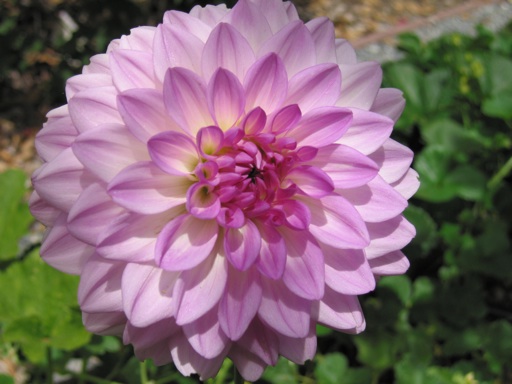
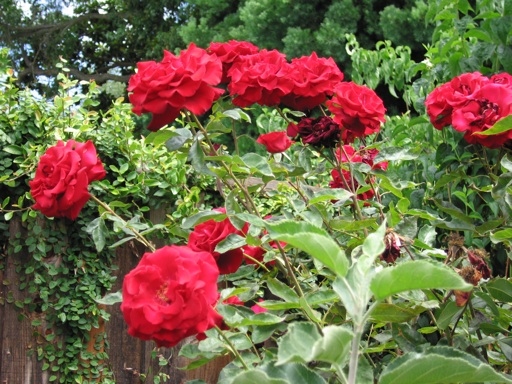
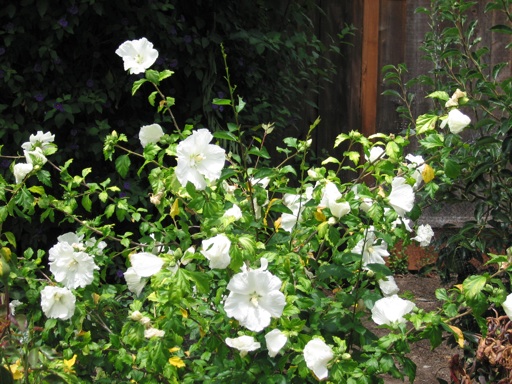
The top picture shows a really interesting purple and white dahlia I am growing this year. I have never had any luck growing dahlias in the ground. As soon as the dahlias sprouted in the spring time, the snails would devour them. They barely had enough time to grow one leaf before they were eaten. Putting snail poison around the dahlias bought some time, but as soon as it began to wash away, the dahlias would get eaten. I just couldn’t be bothered to reapply the snail poison every week or two. The full grown dahlias I planted in the ground didn’t fare much better.
This is the first time I have been successful growing a dahlia. It is growing in our raised bed vegetable garden, which has copper tape all around the wood borders to deter snails and slugs. The copper tape works most of the time, although occasionally one gets in.
The second picture shows our back magic tree rose, which has been in its second bloom of the season for weeks. This rose is one of my favorite roses, because it’s flowers are beautiful, and they last for so long. The third picture shows a white rose of sharon that is now in full bloom in our back yard. Our roses and rose of sharon are all growing in the ground (not in the raised beds). Our snails and slugs don’t seem to be interested in eating these plants.
July 18 2009 | Dahlias and Rose of Sharon and Roses | Comments Off on July Flowers
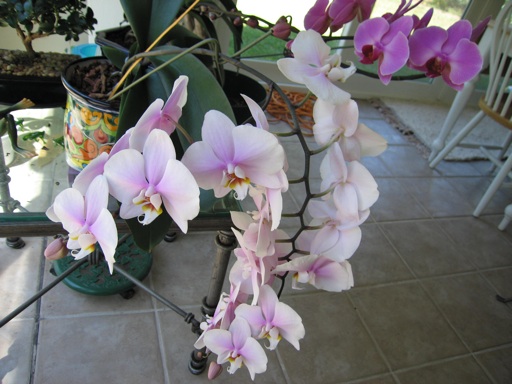
We have three orchids that are growing indoors in pots. Initially, my partner was feeding our orchids with a 20-20-20 water soluble orchid fertilizer every 7-14 days. He would add about a tablespoon of the fertilizer to a water bath in our kitchen sink and soak the pots in it for 5-10 minutes. The orchids were growing slowing and generating flowers.
About 4 months ago, I learned that the 20-20-20 fertilizer tends to stimulate new growth and that an orchid bloom fertilizer will be more likely to simulate flower production. So I purchased an orchid 6-30-30 water soluble orchid bloom fertilizer. I started adding half a tablespoon of the 20-20-20 fertilizer and about half a tablespoon of the 6-30-30 bloom fertilizer to the water bath before soaking the orchids for about 15-30 minutes. I am now fertilizing/watering them every 2 weeks.
Since I started giving our orchids the bloom formula and soaking them for a longer time, our orchids have been generating many more flowers. Our white orchid in the above picture started growing a new stem of flowers off of a flower stem that has been blooming since March. It now has over 20 flowers open at once. The first flowers on this stem that opened in March (see my April 11 post) are still open and show no signs of wilting yet.
July 05 2009 | Orchids | Comments Off on Orchid Bloom Fertilizer
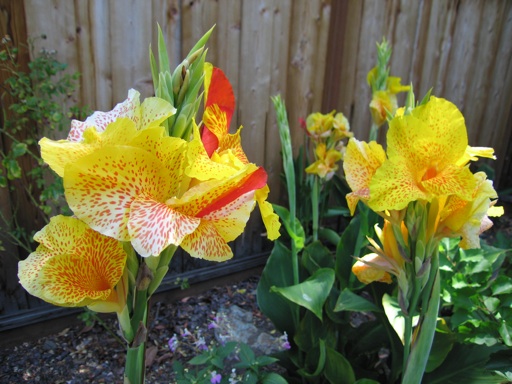

The cannas I planted in our yard a few years ago are flowering again. We are growing red, yellow, and orange cannas. It’s nice to have perennial flowers like cannas in the garden that don’t need to be replanted every year.
Our cannas have grown back year after year with relatively little care. Cannas need watering every few days during our dry season, when I water them with our automatic micro-spray watering system. They also need to be cut to the ground in the fall after bloom. Although, I haven’t ever fertilized them.
Cannas tend to multiply over time by producing new rhizomes. Although, our cannas haven’t spread very fast, and they haven’t been invasive. One can dig up the rhizomes and separate them every few years. The yellow spotted cannas in the first picture above were given to us by a friend who had too many of them.
In our climate where the soil never freezes, I leave our canna rhizomes in the ground over the winter. They survive our occasional frosts and dips into the 20s F without any damage. However, I have been told that in climates that have much colder winters, the top several inches of soil freezes. In these climates, cannas need to be dug up and stored inside in the winter or planted next to a building where they won’t freeze.
June 28 2009 | Cannas | Comments Off on Cannas Are Back
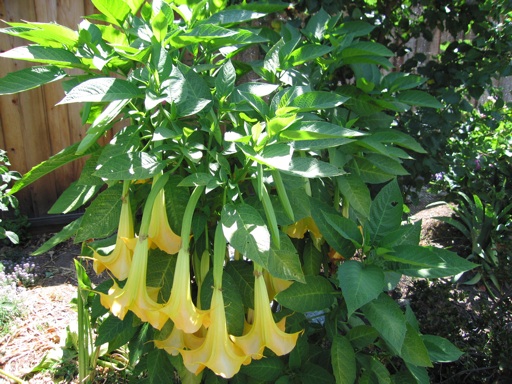
A few years ago, we had a large Charles Grimaldi brugmansia growing in our yard. Every few months, it was full of hundreds of fragrant yellow flowers. Then, in January 2007, we had a hard freeze. The temperature fell into the 20s F for several nights, and our brugmansia died to the ground. Here’s what it used to look like: 7/14/08 Brugmansia post.
Some of the roots survived, but it didn’t grow back right away. Several months later, the roots started to generate a few new shoots. After surviving yet another freezing night in the 20s last January, those shoots have now grown to about four feet tall and are blooming for the first time. It’s great to have it back again. When the sun goes down, we open our kitchen window, and we can smell the flowers inside our house. The flowers have a very unique tropical fragrance. This time I won’t let it grow too large, so that it will be easier to cover during freezing weather.
June 21 2009 | Brugmansia | Comments Off on Brugmansia is Back
« Prev - Next »







